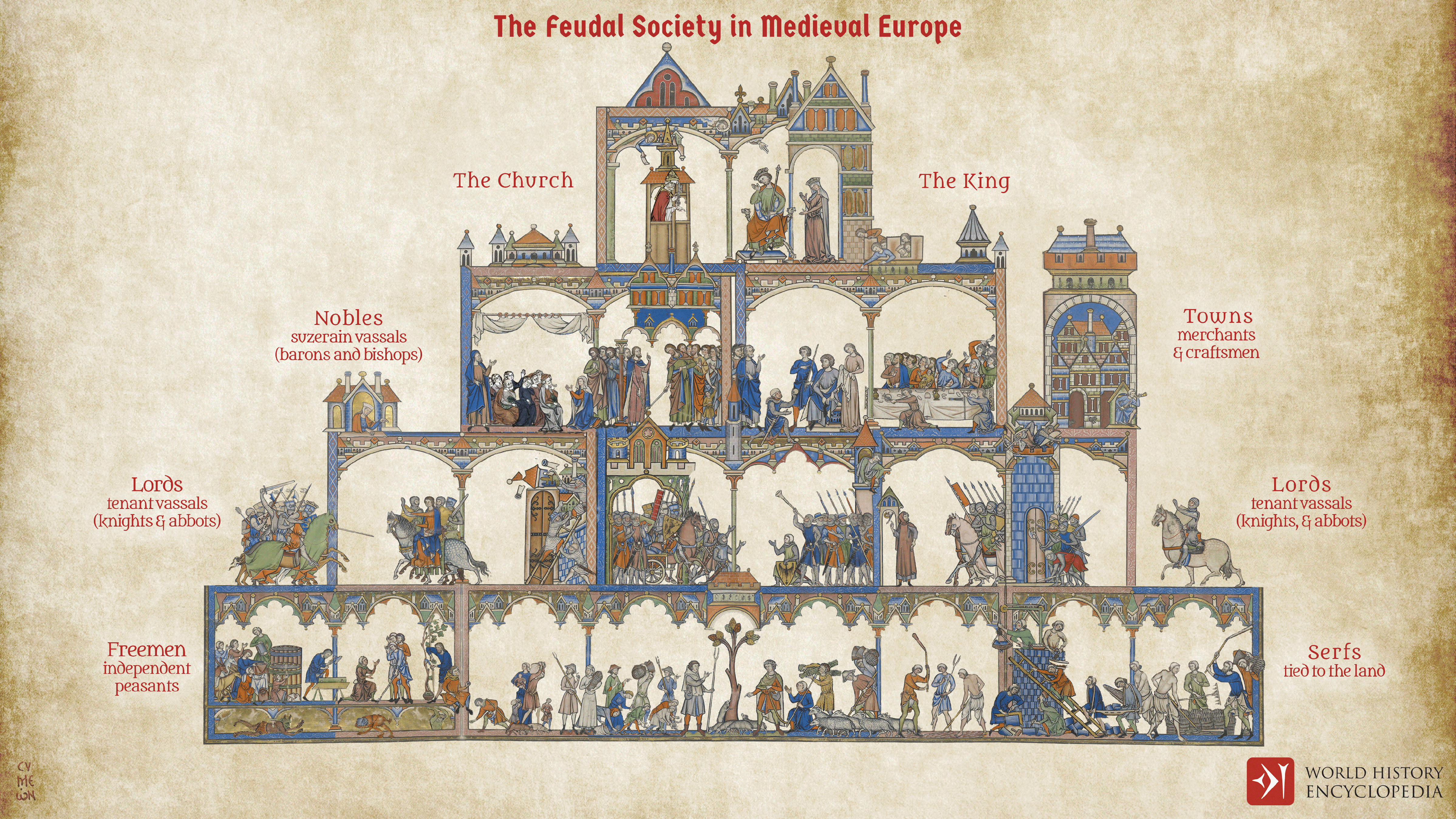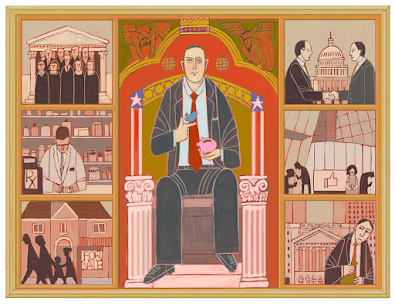The Feudal System
What is the Feudal System?
Oxford English Dictionary defines it as: "The dominant social system in medieval Europe, in which the nobility held lands from the Crown in exchange for military service, and vassals were in turn tenants of the nobles, while the peasants (villeins or serfs) were obliged to live on their lord's land and give him homage, labour, and a share of the produce, notionally in exchange for military protection."
 |
| This photo shows a visual representation of how Feudalism operated. |
The Feudal system has significant importance to the Medieval World and the stories of King Arthur. The system is also known today as “feudalism” or “feudality”, but during the 9th to about 14th-century people did not have a name for the system in which they were living, and it is extremely important to note that there is not necessarily one definition to how this system works because there were different variations of rules and regulations (1). Medieval Latin terms “feudalis” meaning free and “feodum” meaning fief. The fee signified the land given as a payment for regular military service (1)The most common characterization of feudalism was the granting of fiefs, mostly in the form of land done by the King in return for political and military services. The relationship between the two individuals at the top of the ladder was known as the grantor of lord of the grantee, his vassal, but against misconception both individuals were free men, so it is extremely important to recognize the difference between feudalism and Seignorialism (5). The overall thing to know about the feudal system is that it was a complex and growing system that stemmed from land ownership but also included hierarchical obligations governing social interactions and even included power dynamics during Medieval history (2). Understanding the feudal system is crucial for understanding why things were the way they were and how everything operated.
Watch THIS YouTube Video to receive more details on how the system operates.
Rankings within the Feudal System:
Feudalism was known for having people placed on a theoretical ladder, those at the top of the ladder held the most power and those at the bottom had the least amount of power.
At the very top of the ladder was the King:
He was in complete control of how the feudal system operated and owned all the land, and he decided who got to lease out said land (2).
 |
| This photo is another representation of how the social ladder worked. |
Underneath the King were Barons:
Barons were known as the Lord of the Manor and had complete control over the land which they leased (4). In return for having free range of doing with the land, Barons had to serve on the royal council basically meaning they had to pay rent and provide the King with Knights for military services (2).
Underneath Barons were Knights:
Knights received smaller amounts of land provided by Barons in exchange for military services towards the King whenever he demanded them. On top of fighting for the King, the Knights were also in charge of protecting the Baron and his family. They were free to keep as much land as they leased for personal use and then disturb the remaining amounts (2).
Underneath Knights was Bailiffs or Reeves:
Knights could not be every at once so in order to make sure their section of leased land was harvesting crops and paying taxes, supervisors were also assigned to individual towns and manors (4). These supervisors were called reeves, bailiffs, or stewards, and they helped to assist Knights with their everyday jobs (2).
Underneath the Bailiffs were Villeins:
Villeins had no rights and had to provide whoever was above them with free labor, food, and services when and wherever it was asked of them. They were not allowed to leave the town or manor in which they were placed and had to grant permission from higher-ups to marry (2).
At the bottom of the ladder were serfs or peasants:
- Peasants received land usually from the reeves and were never allowed to sell or leave said land. Each year the peasants were required to pay taxes in regards to the crops that they harvested and this money is what supplied the income for each person above them on the ladder (2).
Dismissal of the Feudal System:
As the system became more complex over time the relationship between the lord and vassal seemed to weaken, and thus hurt the effect of trust within the system. One major blow to the system occurred from the sudden population decline that occurred with wars and plagues (6). The black death is said to have taken out such an extreme amount of peasants that there was a chronic shortage of labor and without the bottom of the ladder providing for the rest, it simply was not working how it once did. Another major factor in the decline of feudalism was the Catholic Church. The church disagreed with the rich and powerful nobles, mostly because their wealth threatened their overall power of authority (3). Not to mention the growth of polite culture, and the rise of a more centralized monarchy which included the introduction of firearms. One major concern with the system was that fiefs were often hereditary causing a permanent class divide between those who had land and those who leased or rented the land (1). Not to mention throughout years of enforcing feudalism, it became very difficult to keep track of who owned what land and who rented what land which led to mass confusion and anger.
 |
| The dismal of the system included the rise of many other things and this photo shows a few. |
Citation:
Cartwright, Mark. “Feudalism.” World History Encyclopedia, https://www.worldhistory.org#organization, 7 Aug. 2023, www.worldhistory.org/Feudalism/.
“Decline of Feudalism.” Unacademy, 13 June 2022, unacademy.com/content/karnataka-psc/study-material/history/decline-of-feudalism/.
“Feudal System: Medieval Life and Feudalism.” History, 16 Feb. 2023, www.historyonthenet.com/medieval-life-feudalism-feudal-system.
“Feudalism, Facts, Origins, Development, Features & Decline.” School History, 24 June 2021, schoolhistory.co.uk/medieval/norman-conquest/what-is-feudalism
“The Medieval Feudal System Explained.” History Skills, www.historyskills.com/classroom/year-8/year-8-feudal-system-reading/. Accessed 11 Sept. 2023.
Young, Andrew T. “The Political Economy of Feudalism in Medieval Europe.” Constitutional Political Economy, vol. 32, no. 1, Mar. 2021, pp. 127–44. EBSCOhost,research.ebsco.com/linkprocessor/plink?id=0bd838b4-8975-3a17-9ab4-94c62ff826a6.
“What Was Feudalism in Medieval Europe?” YouTube, YouTube, 8 Apr. 2022, www.youtube.com/watch?v=5Whvf2EPe-g&t=46s.



Hi Miya! I really like your breakdown of the feudal system. It definitely helps me understand exactly how the power structure worked at the time of the stories we're reading. I find it interesting that knights only have a small bit of land compared with Barons, for some reason I was under the assumption that knights basically were Barons. But I guess it makes sense that there would be landowners above them. Definitely not a good system for those at the bottom regardless.
ReplyDelete